Research Paper - (2010) Volume 18, Issue 3
Sabine Van Houdt MSc*
Research Fellow
Jan De Lepeleire MD PhD
Professor
Department of General Practice, Katholieke Universiteit, Leuven, Belgium
Received date: 5 October 2009; Accepted date: 21 March 2010
BackgroundTo ensure coordinated care in complex home care situations in Flanders a system of funded care plans was developed some 15 years ago. In the literature little evidence is found on the value of care plans in home care. The question arises as to whether funding and implementing these care plans has a significant effect on the quality of home care. MethodsA multicentre, non-randomised control group design was used. Care situations with a funded care plan were selected in five Flemish regions. In three control regions, similar situations were chosen. All patients, informal caregivers and healthcare professionals in the selected care situations received a postal questionnaire. Main outcome measures were SF12, the Zarit Burden Scale, satisfaction and hospitalisation. Data were calculated in proportions. Contingency tables were evaluated using the chi-square test. ResultsThere was no significant effect on hospitalisation, the perceived general health of the patient, the perceived burden on the informal caregiver or on satisfaction with the delivered care of all involved. In care situations with a care plan, goals were more often formulated and achieved. A positive correlation was found between formulating goals and adequately evaluating and adjusting care. The healthcare professionals in the intervention group had a more positive attitude towards and participated significantly more in team meetings. Conclusion Care plans in home care lead to significant differences in process, but they have no effect on outcomes for patients and informal caregivers.
access and evaluation, healthcare quality, outcome and process assessment, patient care planning, primary health care
Demographic changes in Western society are generating a growing number of people with chronic diseases and co-morbidity needing long-term care from different caregivers in complex care situations. Moreover, a growing number of people needing complex care, such as people with dementia, are being cared for at home.[1] It is important to ensure quality of care in these complex home care situations. Although there has been interest for quality in home care for decades,[2–4]more critical research in this field is required and to date it has received little attention and discussion. [5,6]Discussions about quality of care have proved difficult because of the wide range of definitions used. The most basic definition states that quality of care can be measured by the client’s satisfaction.[7] The Institute of Medicine covers items such as efficiency, efficacy, continuity of care and safety.[8] These items have also been included in Flemish lawwhen referring to quality of care. Donabedian and Campbell argue that quality is related to structures, processes and outcome of health care, based both at the individual and the population level, and that efficacy and availability should be taken into account.[9,10]
The organisation of care in Flanders is complex.[11] Both the federal and regional governments have jurisdiction and provide financial resources. Different disciplines, involved in the care for the same patient, are organised and financed in different ways. Historically, there have been different trends in the northern part of Belgium (Flanders) and the southern (Wallonia). Because patients can choose healthcare professionals freely, home care teams are very variable. To ensure integrated care, a system of subsidised care plans was developed some 15 years ago, stipulating norms and finances for multidisciplinary teams. If coordination of care is needed, the patient or one of the caregivers in the team can initiate a care plan involving all caregivers. A multidisciplinary team consists of at least three caregivers, including a general practitioner and one or more professionals.
A literature search of several databases (including Medline, CINAHL, BNI, PsychINFO and ISI Citation Indexes) provided 6044 articles about patient care planning, of which 179 were selected based on title and abstract. Most papers were in the form of expert opinions. Only 12 articles dealt with the impact of a care plan.[12–23] Moreover, studies in which the effect of a care plan was analysed did not consider home care.[24] Different studies used different definitions of a care plan.[25–28] An unambiguous definition is needed. Since this study was limited to Flanders, care plans were defined according to Flemish legislation: care plans are multidisciplinary plans intended to provide care which improves the independence and functioning of the patient and supports the (formal and informal) caregivers involved. Flemish legislation considers care plans as a written communication tool between all involved. Care plans include identification of the patient and the caregivers involved, a description of the caregivers’ tasks, arrangements for care and an evaluation of the patient’s situation. Each care plan, developed in accordancewith the legislation, is funded by the regional government,with a maximum funding per region for three per 1000 inhabitants.
The aim of this study was to investigate whether care plans have a significant effect on the perceived quality of home care according to the patients, family caregivers and healthcare professionals involved.
A multicentre, non-randomised control group design was used to measure the differences in the perceived quality of care in situations with and without a care plan. From each of the five provinces of Flanders, one region in which the funded care plans were used to organise complex care situations was included in our study as an intervention region. In these intervention regions, care situations with registered care plans were selected. To select control regions in each of these five provinces, a region in which care plans were not used was selected. Only in three provinces did a regionmeet this selection criterion. Nursing care plans of all patients meeting the criteria of the funded care plans in 2005 were included. All those involved in the selected care plans, patients, family caregivers and healthcare professionals, received a postal questionnaire (Table 1).
The postal questionnaires contained indicators of the different concepts of quality of care: satisfaction; structure, process and outcome; and items relating to efficacy, efficiency, cost-effectiveness and continuity of care. These indicators were also covered by the local legislation about quality of care standards.[8] The structure and availability of services was studied by interviewing stakeholders in the selected regions. The results of these interviews are reported elsewhere.[29]
Patient questionnaire
The patient questionnaire measured satisfaction and registered hospitalisation. Global health functioning was measured with the SF12.[30,31] Because the patients being questioned were elderly, they could choose to fill in the questionnairewith the help of a third party. This was indicated on the questionnaire.
Informal caregivers’ questionnaire
The informal caregivers involved (family members, friends, neighbours) identified in the care plans received a questionnaire with outcome quality items, namely satisfaction, and the Zarit Burden Scale, measuring the degree of burden caused by the caring process.[32,33]
Healthcare professionals’ questionnaire
The healthcare professionals involved were invited to fill in two written questionnaires: one with 21 general statements about the care plan and multidisciplinary meetings and another covering quality items related to the patient’s specific care plan.
An informed consent form was signed according to the current regulations.[34] The protocol was approved by the Ethics Committee of the Faculty of Medicine, Katholieke Universiteit Leuven.
Before the study a formal power calculation was done with Epi-Info1. For a score of 25%, a difference of 15% and a response rate of 50%, a minimumof 330 care plans in each group was estimated to be needed.
Data were imported into an Access database and analysed with SAS V8. All data from the intervention regions were analysed against all data from the control regions. Data were calculated in proportions. Contingency tables were evaluated by the chi-square test. A value ofP<0.05was considered significant.ABonferroni correction was used to adjust for multiple testing.
Demographic data

A comparison of intervention versus control regions yielded relatively similar populations. However, there were large differences in the use of funded care plans in the intervention regions, ranging from 45.02% to 451.25% of the maximum financed care plans (Table 1). In the intervention regions 1022 funded care plans were selected. In the control regions the selection consisted of 323 nursing care plans. Due to privacy agreements, the information from patients in one region was not registered. In three regions information on the informal caregiver had not been registered. In these regions the patients and informal caregivers could not be questioned. In total, 1879 of the 4923 questionnaires sent were returned, representing a total response rate of 38%.
Patient questionnaire (n=972)
A total response rate of 48.1% (n=467) was achieved (Table 2). Only 18.3% of patients completed the questionnaire themselves; 53.3% received assistance from an informal caregiver and in 28.4% of cases the informal caregiver had completed it.
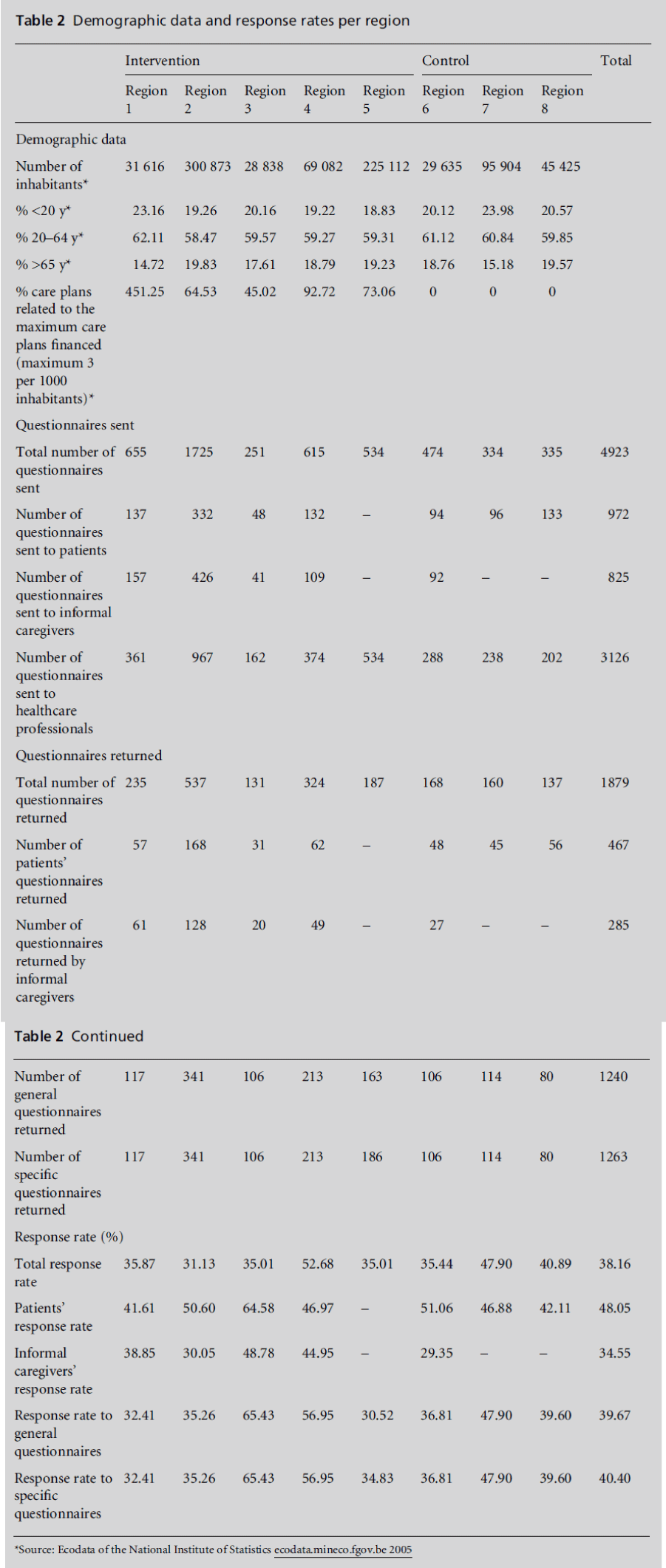
There were no significant differences between the intervention and the control groups in satisfaction with the involvement, coordination and cooperation. A care plan had no effect on the number of registered hospitalisations during the last year or on patients’ global functioning measured with the SF12 (Table 3).
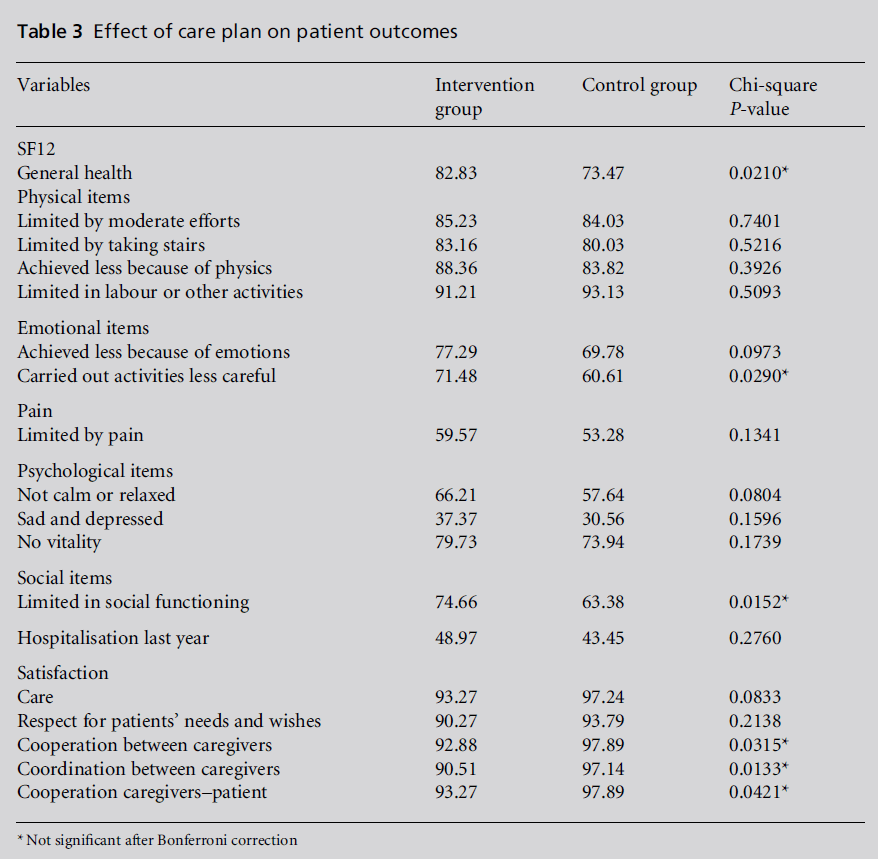
Informal caregivers’ questionnaire (n=825)
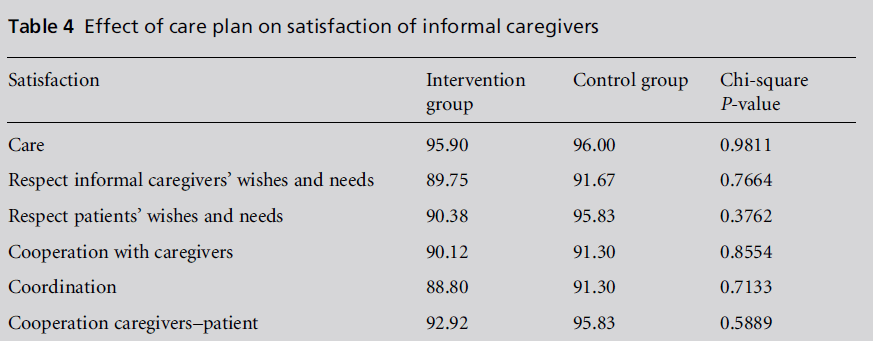
The research team received 34.6% completed questionnaires from informal caregivers (n=285). No differences between the intervention and control groups were found in the satisfaction of informal caregivers with care, in the involvement of patient and informal caregiver and in the coordination and cooperation between professionals and with the informal caregiver (Table 4). Most informal caregivers experienced a high burden of care, measured with the Zarit Burden Scale (90.4% scoring >10). There was no significant difference between the control and intervention groups (P=0.7).
Healthcare professionals’ general questionnaire (n=3126)
The general questionnaire was completed by nurses (32.8%), GPs (31.2%), social workers (11.4%), home care providers (4.5%) and others (20.0%) with a global response rate of 39.7% (n=1240; Table 2). For six out of the 21 items the outcome was significantly different in the intervention group compared with the control group.
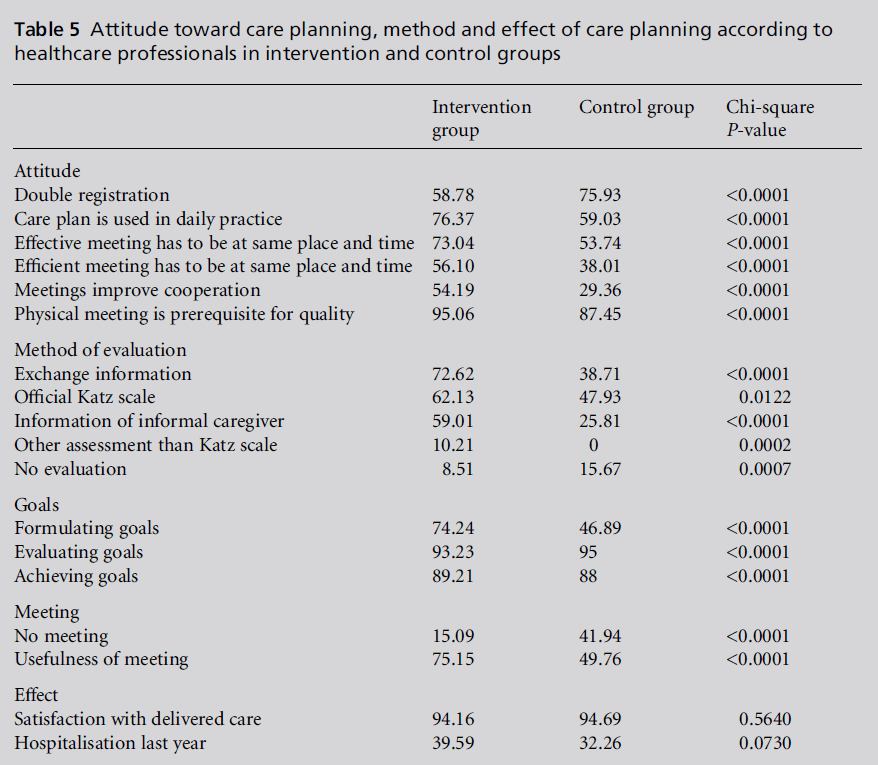
Healthcare professionals in the control group perceived significantly more double registrations of information in the care plan. Healthcare professionals who had already used care plans, responded significantly more often that care plans were used in practice. They also agreed that for meetings to be efficient and effective all healthcare professionals involved should meet at the same place and at the same time.Moreover, significantly more healthcare professionals from the intervention group agreed that multidisciplinary meetings improved cooperation and were a prerequisite for high quality care (Table 5). Further analyses showed that the more experienced the people in multidisciplinary teams, the more they were convinced of the quality improving effect of team meetings.
Healthcare professionals’ questionnaire related to specific care plan (n=3126)
Of the questionnaires related to a specific care plan situation, 1263 (40.4%)were returned (Table 2).Most healthcare professionals questioned in both the intervention and control groups indicated that the care situation was sufficiently evaluated (88.1% and 86.5% respectively). However, there was a significant difference in the method of evaluation. The intervention group evaluated significantly more often by means of information exchange, gathering information from the informal caregivers and using assessment other than the official dependency scale to measure the patient’s care needs. Significantly more healthcare professionals in the control group stated that the care situation was not evaluated (Table 5).
There was a significant difference between intervention and control regions concerning the formulation, evaluation and achievement of goals. In the intervention group goals were more frequently formulated and achieved. Healthcare professionals in the control group stated more often that formulated goals are evaluated.
The healthcare professionals inthe intervention group met significantly more other professionals involved in the same care situation in person and had a more positive attitude about the usefulness of team meetings than those in the control group. According to healthcare professionals from both the intervention and the control groups, the main added value of team meetings was the interdisciplinary contact, the collaboration and the coordination of care.
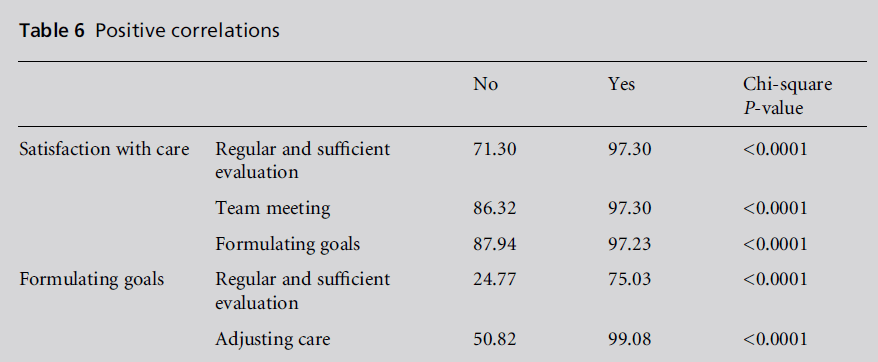
Overall, the satisfaction of healthcare professionals about the care delivered did not differ significantly between control and intervention groups. However, there was a positive correlation between the satisfaction with care delivered and regular and sufficient evaluation of the care situation, team meetings and formulation of goals. The more healthcare professionals indicated that they had formulated goals, the more they perceived that the care was sufficiently evaluated and the more they evaluated and adjusted the care (Table 6).
As to the effect of the care plan, the number of patient hospitalisations registered by healthcare professionals did not differ significantly between intervention and control groups (Table 5).
Main findings
The caring process in situations with home care plans differs significantly with respect to the formulation and achievement of goals from those without care plans. Moreover, healthcare professionals in the intervention group participated significantly more often in team meetings, had a more positive attitude towards these and considered them as a prerequisite for the quality of care. There was a positive correlation between satisfaction on the one hand, and regular and sufficient evaluation, team meetings and formulation of goals on the other.
Nonetheless, there was no significant effect on the measured outcome, namely the satisfaction of all involved, on registered hospitalisations, on perceived general health of the patient and on the experience of burden of the informal caregiver.
Comparison with previous literature
Previous international literature emphasises the formulation of care goals as a crucial element in the development of a care plan.[25–28] From our study it can be concluded that the formulation of care goals, the evaluation of these goals and better communication between healthcare professionals are crucial in providing adequate home care. A care plan stimulates these elements.
A face-to-face meeting with all healthcare professionals involved at the same place at the same time is very valuable. Nonetheless, healthcare professionals emphasise that it is not feasible to participate in a multidisciplinary meeting for every patient. Meetings should be organised only if useful. In a study in Flanders about views concerning team meetings, GPs described these to be useful in terms of being purposeful meetings with time well spent on concrete items that needed work and attention, providing GPs with the opportunity to get to know the other professionals, having a commitment to improving care and having the involvement of both patients and informal caregivers.[35] Moreover, GPs who had positive experiences with team meetings acknowledged the added value of this activity. Our results confirm the findings of this study.
Quality of care is often misunderstood as satisfaction. This study uses a multilevel concept of quality of care taking into account perceptions and views of all those involved, and compares them with those from a control group. Moreover, to measure functional outcome the Zarit Burden Scale and SF12 were integrated in the questionnaires. The results of this quantitative study were confirmed by the results of the interviews with healthcare professionals from the selected regions. These data can be important for policy makers, to help them optimise the system.
Against a background of scarce previous research, this study establishes that, in a given healthcare system, implementing care plans and organising home care teams is beneficial for those in need of home care. Even in studies covering a clearly defined clinical area such as diabetes care, no important differences were detectable.[36] Also, in a randomised controlled trial studying the possible benefit of dementia medication, no proven benefits in hard end points were shown.[37]
Limitation of this study
The data collection was difficult. In many regions data were recorded on paper instead of digitally. Handwriting sometimes had to be deciphered and not all data were complete. Many strategies were used to complete the data.
Using care plans in home care is regarded as a complex intervention, with many factors influencing the care process. Despite existing legislation in Flanders, practice in primary care is diverse.29 In order to control for this diversity an intervention and control region were selected in every province. Nevertheless, only three provinces in each region met the selection criteria. Moreover, because of the variation in numbers of care plans, some regions gained more weight in the results.
Owing to privacy reasons, one region did not register the data of the patients. In three regions the data of informal caregivers were not available. It was not possible to retrieve these data. The response rate could also have been better. Owing to time pressure on the sponsor it was not possible to send participants a reminder. Therefore the number of care plans obtained was sufficient for the healthcare professionals, but insufficient for patients and informal caregivers. If the required number of care plans were achieved for these groups the results would have been more valid.
This study was performed in Flanders. The results can be generalised to other healthcare systems with variable teams in complex home care situations. In Flanders every team is organised on an ad hoc basis as a result of the freedom of choice of professional caregivers by patients and their relatives. We are in doubt as to what the result would have been if fixed teams had been questioned. Experiences in Canada teach us that in order to hold a chaotic world together clustered care is needed rather than very complex structures.[38–41] The Dutch Health Council states that primary care is essentia1.[42–44] In Belgium, there is growing evidence that coordinated care generates a better outcome.45 Given the growing need for home care, in-depth research is required to learn more about the most effective and high-quality way to care for people at home.